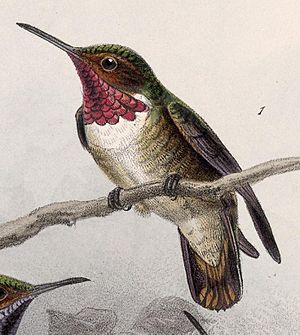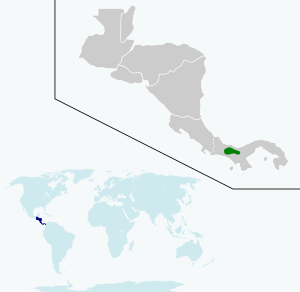Glow-throated hummingbird facts for kids
Quick facts for kids Glow-throated hummingbird |
|
|---|---|
 |
|
| Conservation status | |
| Scientific classification | |
| Genus: |
Selasphorus
|
| Species: |
ardens
|
 |
|
The glow-throated hummingbird (Selasphorus ardens) is a tiny, colorful bird. It's a type of hummingbird that lives only in a small part of Panama, a country in Central America. This special bird is considered an Endangered species, which means it's at high risk of disappearing forever.
Contents
About the Glow-Throated Hummingbird
What is its Scientific Name?
The glow-throated hummingbird has the scientific name Selasphorus ardens. It's the only species in its group, meaning it's quite unique!
How Does it Look?
This hummingbird is about 7 cm (2.8 in) long, which is roughly the size of your finger! Both male and female birds have a short, straight, black beak.
- Males: They have shiny bronze-green feathers on their backs. Their tail feathers are black with reddish-brown edges. The most amazing part is their throat, called a gorget, which is a bright pinkish-red. Below this, they have a white patch. Their chest and belly are also white, with the rest of their underside being a buffy (light brown) color, sometimes with green sparkles.
- Females: They also have bronze-green backs. Their central tail feathers are green, while the others have reddish-brown bases, a black band, and light buffy tips. Their throat is pale buff with gray spots. The rest of their underside looks similar to the male's.
- Young Birds: Baby hummingbirds look a lot like the adult females. They might have rusty edges on the feathers of their head and neck, and more green on their tails.
Where Does it Live?
Its Home in Panama
The glow-throated hummingbird is found only in west-central Panama. Specifically, it lives in the Chiriquí and Veruagas provinces.
Historically, it lived in a wider area. However, since the early 1900s, it has only been seen in a few specific mountains like Cerro Colorado and Cerro Flores in Chiriquí, and Cerro Tute and the Santa Fé district in Veraguas. There have been a few unconfirmed sightings in another area called the Azuero Peninsula, but experts aren't sure if it truly lives there.
Its Forest Habitat
This hummingbird prefers to live at the edges of forests and in clearings within the Talamancan montane forests. These are mountain forests. You can find them at elevations between 750 and 1,800 m (2,500 and 5,900 ft) above sea level.
Behavior and Life
How Does it Move?
Scientists don't know much about how the glow-throated hummingbird moves around. It's not clear if they migrate or stay in the same place all year.
What Does it Eat?
We don't have specific information about what the glow-throated hummingbird eats or how it finds food. However, scientists believe it eats the same things as its close relative, the scintillant hummingbird. Like most hummingbirds, they likely feed on sweet nectar from flowers. They also eat tiny insects, which provide them with important protein.
Reproduction and Life Cycle
Unfortunately, very little is known about how the glow-throated hummingbird breeds or raises its young. Scientists are still trying to learn more about its nesting habits and life cycle.
Does it Sing?
As of July 2022, there are no recorded sounds or songs of the glow-throated hummingbird. Neither the Cornell Lab of Ornithology's Macaulay Library nor xeno-canto (websites that collect bird sounds) have any recordings of its vocalizations.
Conservation Status
Why is it Endangered?
The glow-throated hummingbird is an Endangered species. This means it faces a very high risk of extinction in the wild.
- Shrinking Home: Its habitat has become much smaller since the 1800s.
- Small Population: Experts estimate there are only between 2,000 and 12,000 adult birds left. This number is believed to be decreasing.
- Habitat Loss: Even though some live in Santa Fé National Park, their forest home is being cut down. People are clearing land for farming and for animals to graze.
- Climate Change: These birds live near the tops of mountains. As the climate gets warmer, their habitat might shrink even more, pushing them higher up the mountains until there's no more suitable land.
Protecting these beautiful birds and their forest homes is very important!
See also
 In Spanish: Colibrí ardiente para niños
In Spanish: Colibrí ardiente para niños


